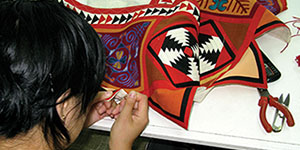
Patchwork is still made in Central Asia, both by traditional communities and by contemporary artists. Several organizations support these preservation efforts including Art Group Tumar and the Central Asia Craft Support Association.
Art Group Tumar, a leader in contemporary design in Kyrgyzstan, has been a presence in Bishkek for almost fifteen years, with galleries in both Bishkek and Almaty, Kazakhstan. The main purpose of the Art Group Tumar is the preservation and revival of Kyrgyz national applied art, and the development of a modern idiom through design and product development. Their goal is to unite artists, designers, and craftsmen throughout the country who create highly imaginative, well designed products based on the national crafts of Kyrgyzstan. Today the company employs 150 people, of which ninety percent are women, in nineteen private production workshops, with high-quality felt accounting for eighty percent of all production. Art Group Tumar now exports to both North America and Europe, greatly increasing their impact upon regional artisanal production.
Great progress has been made through the efforts of the Central Asia Craft Support Association (CACSA), a non-governmental organization founded in 2000. The association reaches craftspeople in over 76 member organizations, from the five Central Asian Republics. CACSA’s goals and objectives include the preservation of the cultural heritage of Central Asian peoples and the protection of professional, civic, economic and social rights of Central Asian craftsmen. Within this construct, patchwork continues to be practiced on multiple levels, in many forms, both in village homes and in contemporary workshops.